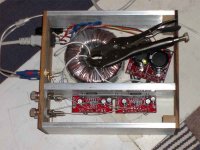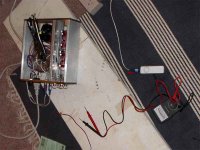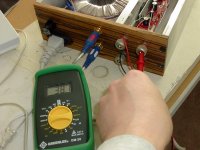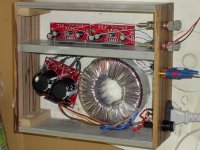Hi,
I had hoped to post a completed amp, without any assistance - "I did it myself." Alas, I'm not experienced enough.
Two questions -
First, How do I make sure this thing is OK to plug into my speakers?
I've hooked it up to a cheap (4$) pair of speakers and they play music, but how can I be sure they won't burn out my nice speakers? I have a multimeter and I looked at Nuuk's frequently asked questions on Decibel Dungeon, but I have never used a multimeter before. It's a really cheap Radio Shack version. I powered up the amp, turned on the multimeter, attached the two leads to the appropriate terminals, turned the dial to 500DCV, then 150DCV, then 15DCV, but I didn't get a reading. I guess that's good - it seems too good. Can someone talk me through this or allay my fears?
Second, I have humming sound.
With the power on and the speakers plugged in, before I plug in my Ipod as the source, there is a loud hum/buzz. When I plug the headphone jack in, with and without music playing, the hum goes away. As you can tell from the picture I've included, I don't have the grounds properly attached to a grounding point on the chassis. I plan to get pieces of perforated aluminum for the top and bottom.
When this is all over, I will post a more formal introduction/unveiling of my amp, but for the time being, can someone help me with these two issues?
Thanks
I had hoped to post a completed amp, without any assistance - "I did it myself." Alas, I'm not experienced enough.
Two questions -
First, How do I make sure this thing is OK to plug into my speakers?
I've hooked it up to a cheap (4$) pair of speakers and they play music, but how can I be sure they won't burn out my nice speakers? I have a multimeter and I looked at Nuuk's frequently asked questions on Decibel Dungeon, but I have never used a multimeter before. It's a really cheap Radio Shack version. I powered up the amp, turned on the multimeter, attached the two leads to the appropriate terminals, turned the dial to 500DCV, then 150DCV, then 15DCV, but I didn't get a reading. I guess that's good - it seems too good. Can someone talk me through this or allay my fears?
Second, I have humming sound.
With the power on and the speakers plugged in, before I plug in my Ipod as the source, there is a loud hum/buzz. When I plug the headphone jack in, with and without music playing, the hum goes away. As you can tell from the picture I've included, I don't have the grounds properly attached to a grounding point on the chassis. I plan to get pieces of perforated aluminum for the top and bottom.
When this is all over, I will post a more formal introduction/unveiling of my amp, but for the time being, can someone help me with these two issues?
Thanks
Attachments
I don't have the grounds properly attached to a grounding point on the chassis.
That's most likely the source of that buzz or hum. Somewhere your -'s from input and outputs should be grounded to the chasis. Nuuk's site also outlines a the use of a small R/C (resistor/capacitor) circuit to attach these points to ground.
Lose the vise grips. They are truly an accident waiting to happen. They could lead to a fatal shock or worse, a damaged amp!
I don't have the grounds properly attached to a grounding point on the chassis.
That's most likely the source of that buzz or hum. Somewhere your -'s from input and outputs should be grounded to the chasis. Nuuk's site also outlines a the use of a small R/C (resistor/capacitor) circuit to attach these points to ground.
Lose the vise grips. They are truly an accident waiting to happen. They could lead to a fatal shock or worse, a damaged amp!
Thanks Chipco,
You're right, the vice grips are inviting danger. They were the best thing I had on hand to mash all the ground lines together. I should use something that isn't so handle-like, and therefore easy to grab. I guess I will worry about the grounding issue when I finish the top and bottom. Maybe that will make the hum go away. I will also check out Nuuk's site on this question.
In the meantime...
Would anyone like to care to comment on the measurement issue? I'm really looking forward to hearing what this thing can do on my Seas two-ways, but I'm a little shy. I don't want to burn them up.
You're right, the vice grips are inviting danger. They were the best thing I had on hand to mash all the ground lines together. I should use something that isn't so handle-like, and therefore easy to grab. I guess I will worry about the grounding issue when I finish the top and bottom. Maybe that will make the hum go away. I will also check out Nuuk's site on this question.
In the meantime...
Would anyone like to care to comment on the measurement issue? I'm really looking forward to hearing what this thing can do on my Seas two-ways, but I'm a little shy. I don't want to burn them up.
The measurement of the output voltage is in mV's on the DC scale. Most likely should be less than ~20mV. It would most likely be safe on anything less than 50mV but hat usually indicates something isn't quite right.
Now that you mention the specific use of the visegrips, they are at that point an antenna in the magnetic flux of the toroid. I bet it hums real good, eh? Just solder those wires together and wrap some tape around the junction. The first grounding scheme is rarely the solution.
Move those grounds out of the way of the toroid understanding that a doubling of distance reduces the influence of the noise of the toroid exponentionally.
Now that you mention the specific use of the visegrips, they are at that point an antenna in the magnetic flux of the toroid. I bet it hums real good, eh? Just solder those wires together and wrap some tape around the junction. The first grounding scheme is rarely the solution.
Move those grounds out of the way of the toroid understanding that a doubling of distance reduces the influence of the noise of the toroid exponentionally.
Measurement
You will not want your amplifier to output DC to your speakers, this is the way in which the speakers will blow up-- the woofer not the tweeter (assuming you have some kind of crossover in there).
Put your meter into its most sensitive DC mode, what is it 1V or .01V? Place the + and - of your meter across the speaker terminals (with no input) and measure the amount of DC you have, if its less than 25mV (.025V) or even less than .1V then you should not have a problem.
I see you tried this on 500V, 50V, and 15V, but those scales are much too high for you to see the small voltages you were looking for.
You will not want your amplifier to output DC to your speakers, this is the way in which the speakers will blow up-- the woofer not the tweeter (assuming you have some kind of crossover in there).
Put your meter into its most sensitive DC mode, what is it 1V or .01V? Place the + and - of your meter across the speaker terminals (with no input) and measure the amount of DC you have, if its less than 25mV (.025V) or even less than .1V then you should not have a problem.
I see you tried this on 500V, 50V, and 15V, but those scales are much too high for you to see the small voltages you were looking for.
i see you have the input wires super close to the transformer. it would have been better if they were on the other side of the aluminium bar.
anyways i believe that is where the hum comes from. especially as it is reduced when you plug something in.
if its not too late can you swap the transformer and power supply locations? it will reduce the hum
anyways i believe that is where the hum comes from. especially as it is reduced when you plug something in.
if its not too late can you swap the transformer and power supply locations? it will reduce the hum
OK, chipco, I will lose the vise grips before I turn it back on. I hadn't thought about the flux (and probably would never have thought it). This first grounding scheme is obviously not the best solution (I had though of that).
lgreen, thanks for the detail about the DC, but my multimeter only goes down to 15DCV. Based upon your reply, am I correct that my multimeter simply will not detect the level of voltage we're talking about? Do I need a more sensitive multimeter to be sure? Like I said earlier, I have hooked them up through a set of cheap speakers and when the music's playing they sound just fine.
Neutron 7, that's interesting about the input location. I hadn't really thought about this. I should be able to swap the locations. Is it the wire that picks up the signal, not the RCAs? If so, I could keep the wires on the other side of the bar for the length of the chassis, or drill a hole at the very end, to feed the input wires through so they had very little interaction with the donut.
Thanks guys. diyaudio is simply amazing.
lgreen, thanks for the detail about the DC, but my multimeter only goes down to 15DCV. Based upon your reply, am I correct that my multimeter simply will not detect the level of voltage we're talking about? Do I need a more sensitive multimeter to be sure? Like I said earlier, I have hooked them up through a set of cheap speakers and when the music's playing they sound just fine.
Neutron 7, that's interesting about the input location. I hadn't really thought about this. I should be able to swap the locations. Is it the wire that picks up the signal, not the RCAs? If so, I could keep the wires on the other side of the bar for the length of the chassis, or drill a hole at the very end, to feed the input wires through so they had very little interaction with the donut.
Thanks guys. diyaudio is simply amazing.
schmalex said:OK, chipco, I will lose the vise grips before I turn it back on. I hadn't thought about the flux (and probably would never have thought it). This first grounding scheme is obviously not the best solution (I had though of that).
lgreen, thanks for the detail about the DC, but my multimeter only goes down to 15DCV. Based upon your reply, am I correct that my multimeter simply will not detect the level of voltage we're talking about? Do I need a more sensitive multimeter to be sure? Like I said earlier, I have hooked them up through a set of cheap speakers and when the music's playing they sound just fine.
***
Thanks guys. diyaudio is simply amazing.
Yes, at 15V scale your needle will move so little that you will not be able to see how much DC you have on the speaker terminals. Hey, on the plus side you know you don't have the rail voltage on the outputs, which is good. You can get a digital DMM for less than $20 on ebay or at various sites. Here is one cheap DMM and there are many more, for another $10, you get a much better one.
I agree that the wrench may be giving you a shorted turn (search this term) and/or picking up noise. Looks like its resting on wood but if it touches metal you are going to have a big issue.
Measuring DC output
OK, I purchased a better multimeter and took off the vise grip. I soldered the ground wires together and taped the end, as per Chipco's suggestion.
For the measurement of the output voltage - when I put the MM in its lowest setting, 200m I get a reading around 38, though it seems to fluctuate up to 45. But it doesn't seem to go over 50. Does that mean it's safe? I'd really like to plug this thing in to my nice speakers.
Here's a picture of what's going on.
OK, I purchased a better multimeter and took off the vise grip. I soldered the ground wires together and taped the end, as per Chipco's suggestion.
For the measurement of the output voltage - when I put the MM in its lowest setting, 200m I get a reading around 38, though it seems to fluctuate up to 45. But it doesn't seem to go over 50. Does that mean it's safe? I'd really like to plug this thing in to my nice speakers.
Here's a picture of what's going on.
Attachments
schmalex said:Run it like I stole it, that's funny.
What do you mean the input should be shorted?
When you have no source connected to input
and should make measurements, it is better to put a piece of wire
between + an - of input connector.
You put a 'shortcut' - a short across input terminal.
This will give an 'zero input' signal.
Amplifiers do not always like it, when input jack is unplugged.
The input part can even act as an antenna and so disturb measurments.
- Status
- This old topic is closed. If you want to reopen this topic, contact a moderator using the "Report Post" button.
- Home
- Amplifiers
- Chip Amps
- I stand on the precipice of Completion - Pic and Question



